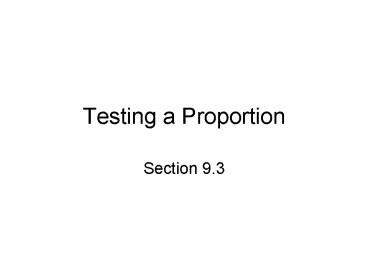Testing a Proportion - PowerPoint PPT Presentation
1 / 19
Title:
Testing a Proportion
Description:
Let r be the binomial random variable, the number of successes out of n independent trials. ... A botanist has produced a new variety of hybrid wheat that is ... – PowerPoint PPT presentation
Number of Views:54
Avg rating:3.0/5.0
Title: Testing a Proportion
1
Testing a Proportion
- Section 9.3
2
Tests Involving a Proportion
- We will test claims that a given percentage of
the population fits a certain description.
3
Let r be the binomial random variable, the number
of successes out of n independent trials.
4
For large samples (np gt 5 and nq gt 5)
5
(No Transcript)
6
Although we could calculate P using the z value,
we will use the TI-83 to calculate P as shown on
the next slide
7
Hypothesis Testing of a Proportion Using the Ti-83
- Press STAT
- Move cursor over to TESTS
- Move cursor down to 5 1-PropZTest
- Press ENTER
- Input p0, x, n, and highlight left, right or
- two-tailed alternative
- Highlight Calculate and press ENTER
- Read z and P.
- If P gt ? do not reject Ho
- If p ? ? reject Ho
8
In the past, college officials observed that 40
of students took advantage of early registration.
This semester, of 4830 students, 2077 took
advantage of early registration. Use a 5 level
of significance to test the claim that a higher
percentage of students now participates in early
registration.
9
In the past, college officials observed that 40
of students took advantage of early registration.
...
- H0 ? 0.40
10
test the claim that a higher percentage of
students now participates in early registration.
- H1 ? gt 0.40
- Use a right-tailed test.
11
This semester, of 4830 students, 2077 took
advantage of early registration. ...
12
Using the Ti-83 With Student Data
- Press STAT
- Move cursor over to TESTS
- Move cursor down to 5 1-PropZTest
- Press ENTER
- Input p0 .4 , x 2077, n 4830 , and
highlight right-tailed alternative - Highlight Calculate and press ENTER
- Read p 1.02 E-5 lt ? .05
- So we reject H0
13
We conclude that more students are now taking
advantage of early registration
14
Test the following hypothesis involving a
proportion
- H0 p 0.70
- H1 p ? 0.70
- Use ? 0.01
- Suppose that in 120 trials there were 80
successes.
15
H0 p 0.70H1 p ? 0.70? 0.01
- We perform a two-tailed test.
16
Suppose in 120 trials there were 80 successes.
17
Test the hypothesis involving a proportion using
the P value approach
Using TI-83 We calculate P .4255 gt ?
0.01 So we do not reject H0
18
Example 6 page 517 A team of eye surgeons has
developed a new Technique for a risky eye
operation to restore the sight of people Blinded
from a certain disease. Under the old method, it
is known that only 30 of the patients who
undergo this operation recover their eyesight.
Suppose that surgeons in various hospitals have
performed a total of 225 operations using the new
method and that 88 have been successful. Can we
justify the claim that the new method is better
than the old one? Use a 1 level of
significance. Solution The p-value, .0014, is
smaller than alpha, .01, Therefore we reject the
null in favor of the alternate hypothesis. The
evidence is strong enough to state that the new
procedure has a higher success rate than the old
procedure at the 1 level of significance.
19
Guided Exercise 5 page 519 A botanist has
produced a new variety of hybrid wheat that is
better able to withstand drought than other
varieties. The botanist knows that for the parent
plants the proportion of seeds Germinating is
80. The proportion of seeds germinating for
the Hybrid variety is unknown, but the botanist
claims that it is 80. To test this claim, 400
seeds from the hybrid plant are tested, and it is
found that 312 germinated. Use a 5 level of
significance to test the claim that the
proportion germinating for the hybrid is
80. Solution The p-value, .3173, is larger
than alpha, .05, therefore, we do not reject the
null hypothesis. The claim of the botanist is
justified at the 5 level of significance.































